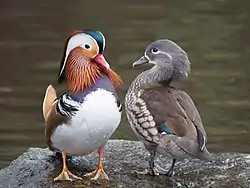鴛鴦
Chinese
| trad. (鴛鴦) | 鴛 | 鴦 | |
|---|---|---|---|
| simp. (鸳鸯) | 鸳 | 鸯 | |

.jpg.webp)
Pronunciation
Noun
鴛鴦
Derived terms
Descendants
Others:
- Zhuang: roegyaemyieng
Japanese

Etymology 1
| Kanji in this term | |
|---|---|
| 鴛 | 鴦 |
| Hyōgaiji | Hyōgaiji |
| Irregular | |
From 愛し (oshi, “dear, loving”, classical Japanese adjective), from the way the ducks are believed to mate for life and seldom stray far from one another.
The spelling is jukujikun (熟字訓) from Chinese, with 鴛 representing the male bird and 鴦 representing the female bird.
Noun
鴛鴦 (hiragana おし, katakana オシ, rōmaji oshi, historical hiragana をし, historical katakana ヲシ)
- (chiefly in compounds) a mandarin duck, Aix galericulata
- a kind of 家紋 (kamon, “family crest”) featuring a mandarin duck
Derived terms
- アメリカオシ (amerika oshi)
Etymology 2
| Kanji in this term | |
|---|---|
| 鴛 | 鴦 |
| Hyōgaiji | Hyōgaiji |
| Irregular | |
Originally a compound of 愛し (oshi, “loving”) + 鳥 (tori, “bird”), from the way the ducks are believed to mate for life and seldom stray far from one another. The tori changes to dori as an instance of rendaku (連濁).
The spelling is jukujikun (熟字訓) from Chinese, with 鴛 representing the male bird and 鴦 representing the female bird.
Pronunciation
Noun
鴛鴦 (hiragana おしどり, katakana オシドリ, rōmaji oshidori, historical hiragana をしどり, historical katakana ヲシドリ)
- a mandarin duck, Aix galericulata
- (figuratively) a pair of lovebirds, a loving couple
- a topknot or bun hairstyle wherein the hair is bunched on each side in a shape vaguely resembling two mandarin ducks
Usage notes
As with many terms that name organisms, this term is often spelled in katakana, especially in biological contexts, as オシドリ.
Etymology 3
| Kanji in this term | |
|---|---|
| 鴛 | 鴦 |
| えん Hyōgaiji |
おう Hyōgaiji |
| on’yomi | |
/weɴau/ → /weɴɔː/ → /eɴoː/
From Middle Chinese 鴛鴦 (MC ʔʉɐn|ʔuən ʔɨɐŋ|ʔɑŋ, literally “male mandarin duck + female mandarin duck”).
Noun
鴛鴦 (hiragana えんおう, rōmaji en'ō, historical hiragana ゑんあう)
- (rare) a mandarin duck, Aix galericulata
- (rare, figuratively) a pair of lovebirds, a loving couple